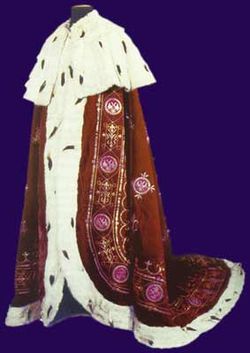- Serbian Royal Regalia
-
Serbia, like most European nations and former monarchies, has a history of crowns worn by its rulers. Serbia has had many rulers and royal families. As such Serbia has several distinct crowns followed by many jewels and other treasures of incredible wealth. As far as know, there are evidences of four Serbian royal crowns, of which only one is in Serbia today.[1]
Contents
Nemanjić Crowns
The Nemanjić Crown Jewels were used for the coronation of the House of Nemanjić. Crown of Stefan Dečanski is now kept in the Cetinje Monastery in Cetinje, Montenegro.[2] There are also some historic data that crown of House of Hohenstaufen once belonged to the some of the Serbian medieval rulers.[1] Also, in Vienna Royal Treasury can be found two of the crowns that belonged to the knez Stefan Bockaj. Together with the crown one golden mantle buckle was captured from Ottomans by town of Kronstadt.[1][3]
Karađorđević Crown
The Karađorđević Crown Jewels were created in 1904 for the coronation of King Peter I. The pieces were made from material that included bronze of Karađorđe's cannon. This gesture was symbolic because 1904 was the 100th anniversary of the First Serbian Uprising. They were made in Paris by the famous Falise brothers jewellery company. This crown is only Serbian crown that is today held in Serbia.[1]
Regalia
The Karađorđević Serbian Royal Regalia consist of the following:
- Royal crown (Also known as Karađorđević Crown)
- Royal orb
- Royal scepter
- Royal Mantle buckle
- Royal Mantle
The crown, scepter and orb are decorated with gemstones found in Serbia and enameled in the national colours of red, blue and white. The Royal Mantle is made of purple velvet, embroidered with gold and lined with ermine fur.[4]
Gallery
-
King Peter I coronation, wearing Royal regalia
-
King Peter I Coronation (1904)
-
Coat of arms of the Kingdom of Yugoslavia, with Royal Crown
See also
References
- ^ a b c d Lazarević, Veselin. "(NE)SAČUVANA SRPSKA BAŠTINA". Vratiti srpske krune. Dan online. http://www.dan.co.me/?nivo=3&datum=2007-11-20&rubrika=Feljton&najdatum=2007-11-17&clanak=124918. Retrieved 22 October 2010. (Serbian)
- ^ Cetinje
- ^ Fessler, Ignaz Aurelius (1815-1825). Die Geschichten der Ungarn und ihrer Landsassen. Leipzig.
- ^ Official Website of The Serbian Royal Family
links
Serbian Royal Regalia  Karađorđević Crown · Serbian Royal Orb · Serbian Royal Scepter · Serbian Royal Mantle Buckle
Karađorđević Crown · Serbian Royal Orb · Serbian Royal Scepter · Serbian Royal Mantle Buckle Serbian Royal Mantle
Serbian Royal MantleNational symbols of Serbia 
Constitutional Cultural icons HeraldryFauna & FloraMonuments UNESCOOtherPeople Patron SaintDepicted on
Serbian dinarNikola Tesla (Science) · Vuk Karadžić (Linguistics) · Petar II Njegoš (Poetry) · Stevan Mokranjac (Composer) ·
Nadežda Petrović (Painter) · Jovan Cvijić (Geographer) · Đorđe Vajfert (Business) · Slobodan Jovanović (Intellectual)Names and codes Unofficial Serbian epic poetry · Three-fingers salute · Mottos (Only Unity Saves the Serbs) · National costume (Šajkača · Opanak)Category Crown jewels by country Austria · Brazil · Czech Republic · Denmark · France · Germany (Bavaria · Prussia) · Greece · Hungary · Holy Roman Empire · Iran · Ireland · Japan · Malaysia · Madagascar · Netherlands · Nigeria · Norway · Poland · Romania · Russia · Serbia · Spain · Sweden · Thailand · United Kingdom (Scotland · Wales)Former or historical sovereign states shown in italics Categories:- Crowns
- Crown jewels
- History of Serbia
- National symbols of Serbia
- National symbols of Yugoslavia
Wikimedia Foundation. 2010.






